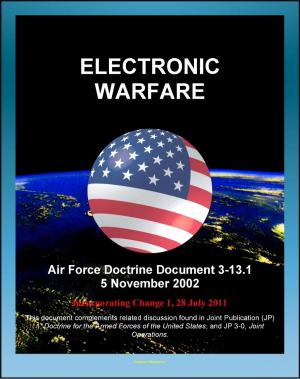The Air Force in Southeast Asia: Tactics and Techniques of Electronic Warfare - Electronic Countermeasures in the Air War Against North Vietnam 1965-1973 - Wild Weasel, Linebacker, B-52
Nonfiction, Science & Nature, Technology, Aeronautics & Astronautics, History, Military, Vietnam War, Asian| Author: | Progressive Management | ISBN: | 9781310091827 |
| Publisher: | Progressive Management | Publication: | November 12, 2013 |
| Imprint: | Smashwords Edition | Language: | English |
| Author: | Progressive Management |
| ISBN: | 9781310091827 |
| Publisher: | Progressive Management |
| Publication: | November 12, 2013 |
| Imprint: | Smashwords Edition |
| Language: | English |
Electronic countermeasures support for the air war against North Vietnam included stand-off jamming, Wild Weasel operations, the use of self-protection pods, and the employment of chaff. The use of rudimentary counter-measures began during World War II and continued in the Korean conflict. Despite this experience, and an on-going program of research and development, the U.S. Air Force was hard-pressed to neutralize North Vietnams radar-controlled defenses, but did prevail and successfully delivered punishing blows during Linebacker II in December 1972. Closely related to the countermeasures effort was the use of the specially equipped aircraft of the Big Eye (later redesignated College Eye) task force. This unit gradually ac-the skill and equipment that enabled it effectively to direct friendly fighters against MIG interceptors. In 1972, however, College Eye yielded some of its earlier responsibilities to other control agencies. Electronic countermeasures is but one aspect of the broad subject of electronic warfare, which was waged in all its complexity throughout Southeast Asia. Nevertheless, in choosing to deal with this topic, the Office of Air Force History faced a difficult security problem, for key material is so closely held that its inclusion might result in a history to which the average Air Force officer would not have access. As a result, this special intelligence was not used. Instead, various agencies involved in electronic countermeasures, having access to material not available to the historian, were invited to comment on a draft of the monograph, to ensure an essentially correct account.
Topics covered include: Wild Weasel, Linebacker I and II, B-52, Rivet Top, Project Vampyrus, Big Eye Aircraft, Rolling Thunder, Fan Song Radar, EC-121D, College Eye, F-105F, Hunter-Killer Team, Lockheed Constellation, Iron Hand, College Eye History, ADC Big Eye / College Eye Report, Project CHECO, the F-111 in Southeast Asia, Project Corona Harvest Special Report, Ryan's Raiders, Missiles and Guided Weapons in Southeast Asia.
Unlike the broader subject of electronic warfare, which originated with interceptions of radio traffic during World War I, electronic countermeasures began with the appearance of radar-directed air defenses in World War II. The first systematic use of electronic countermeasures occurred when British night bombers employed various devices to blind German radar and disrupt communications between defending pilots and ground controllers. U. S. Army Air Forces also conducted wartime countermeasures operations, and during the Korean fighting the U. S. Air Force used equipment and techniques developed for World War II. In the years that followed, the United States .sought to keep pace with improvements in radar by devising new countermeasures, especially for the strategic bomber force, though for tactical aircraft as well.
The Vietnam war tested the recent developments in electronic countermeasures. At first, radar-controlled surface-to-air missiles and antiaircraft guns had the advantage. The Air Force, however, perfected a countermeasures pod for fighter-bombers, and fitted out and armed aircraft for the express purpose of locating and destroying missile sites. These endeavors, complemented by long-range jamming and by countermeasures aircraft from the other services, succeeded in restoring a balance favorable to the offense.
The deadly struggle continued throughout the war. The North Vietnamese adjusted their radars and electronic techniques to neutralize American countermeasures, and the Americans reacted to the changing threat. The countermeasures effort reached its climax in Linebacker II, the B-52 attacks of December 1972 against the Hanoi-Haiphong region. The entire wartime experience was compressed into a few days, as each side sought to overcome the electronic tactics employed by the other.
Electronic countermeasures support for the air war against North Vietnam included stand-off jamming, Wild Weasel operations, the use of self-protection pods, and the employment of chaff. The use of rudimentary counter-measures began during World War II and continued in the Korean conflict. Despite this experience, and an on-going program of research and development, the U.S. Air Force was hard-pressed to neutralize North Vietnams radar-controlled defenses, but did prevail and successfully delivered punishing blows during Linebacker II in December 1972. Closely related to the countermeasures effort was the use of the specially equipped aircraft of the Big Eye (later redesignated College Eye) task force. This unit gradually ac-the skill and equipment that enabled it effectively to direct friendly fighters against MIG interceptors. In 1972, however, College Eye yielded some of its earlier responsibilities to other control agencies. Electronic countermeasures is but one aspect of the broad subject of electronic warfare, which was waged in all its complexity throughout Southeast Asia. Nevertheless, in choosing to deal with this topic, the Office of Air Force History faced a difficult security problem, for key material is so closely held that its inclusion might result in a history to which the average Air Force officer would not have access. As a result, this special intelligence was not used. Instead, various agencies involved in electronic countermeasures, having access to material not available to the historian, were invited to comment on a draft of the monograph, to ensure an essentially correct account.
Topics covered include: Wild Weasel, Linebacker I and II, B-52, Rivet Top, Project Vampyrus, Big Eye Aircraft, Rolling Thunder, Fan Song Radar, EC-121D, College Eye, F-105F, Hunter-Killer Team, Lockheed Constellation, Iron Hand, College Eye History, ADC Big Eye / College Eye Report, Project CHECO, the F-111 in Southeast Asia, Project Corona Harvest Special Report, Ryan's Raiders, Missiles and Guided Weapons in Southeast Asia.
Unlike the broader subject of electronic warfare, which originated with interceptions of radio traffic during World War I, electronic countermeasures began with the appearance of radar-directed air defenses in World War II. The first systematic use of electronic countermeasures occurred when British night bombers employed various devices to blind German radar and disrupt communications between defending pilots and ground controllers. U. S. Army Air Forces also conducted wartime countermeasures operations, and during the Korean fighting the U. S. Air Force used equipment and techniques developed for World War II. In the years that followed, the United States .sought to keep pace with improvements in radar by devising new countermeasures, especially for the strategic bomber force, though for tactical aircraft as well.
The Vietnam war tested the recent developments in electronic countermeasures. At first, radar-controlled surface-to-air missiles and antiaircraft guns had the advantage. The Air Force, however, perfected a countermeasures pod for fighter-bombers, and fitted out and armed aircraft for the express purpose of locating and destroying missile sites. These endeavors, complemented by long-range jamming and by countermeasures aircraft from the other services, succeeded in restoring a balance favorable to the offense.
The deadly struggle continued throughout the war. The North Vietnamese adjusted their radars and electronic techniques to neutralize American countermeasures, and the Americans reacted to the changing threat. The countermeasures effort reached its climax in Linebacker II, the B-52 attacks of December 1972 against the Hanoi-Haiphong region. The entire wartime experience was compressed into a few days, as each side sought to overcome the electronic tactics employed by the other.















